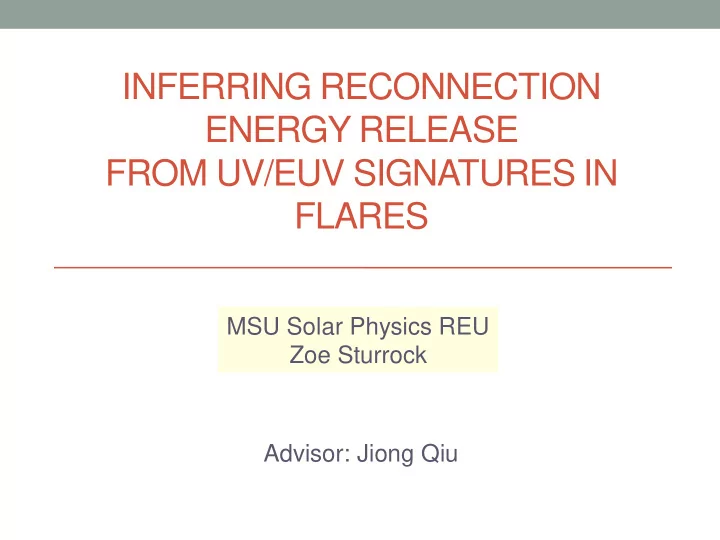

INFERRING RECONNECTION ENERGY RELEASE FROM UV/EUV SIGNATURES IN FLARES MSU Solar Physics REU Zoe Sturrock Advisor: Jiong Qiu
Outline • General background (Magnetic reconnection) • Project outline • Model • Results and comparison with observations • Summary
Magnetic Reconnection Main phase of flare: Oppositely directed field lines reconnect This brings the system to a lower energy state Energy released - • heats chromosphere • forming flare ribbons – observable in UV • outlines feet of coronal flare loops • Infer magnetic reconnection rates and energy release rates from time series of flare images
Heat Flux (F H ) Heat flux - from hot corona to the chromosphere Initial Stage – F H > radiation flux (excess heat flux) -drives chromospheric evaporation - Heated plasma transferred from chromosphere to corona Later stage - F H < radiation flux (deficient heat flux) Plasma is drained from coronal loop through cooling – coronal condensation
Project Outline Aim: Study evolution of flare radiation at foot-points, measure parameters for reconnection and search for a better understanding of the relationship between reconnection and energization of plasmas in flux tubes • Magnetic reconnection (observe through UV signatures) • Energy release (heating functions inferred from UV light curve) • Plasma Evolution (modelled by EBTEL) • Flare radiation (measured by AIA) • Modelling radiation output using EBTEL to compare with AIA observations • Key parameter - energy loss through TR (new model)
Measuring Magnetic Reconnection • Conservation of magnetic flux - infer magnetic reconnection flux by measuring magnetic flux present in newly formed flaring regions in the chromosphere • Measure the reconnection rate: • Faraday’s Law • Energy release rate per unit flux =
Observations C3.2 flare obtained by AIA/SDO on 1 st August 2010 Time: 8UT Time: 10:20 UT
Heating Function • UV light curve of individual pixels reflect timing, amplitude and duration of individual energy release events. • Rise phase - half Gaussian: • Decay phase - exponential: • H(t)= λ I(t) where λ is the total heating factor • Long decay phase cannot be explained by conductive or radiative cooling -> overlying coronal radiation
Measuring Magnetic Reconnection Total recon: +ve = 7.7 x 10 20 Mx, -ve = -2.6 x 10 20 Mx Total heating energy = 1.6x10 30 ergs
EBTEL Model • 0D Enthalpy Based Thermal Evolution Of Loops Model describes average temperature, density and pressure across a coronal strand (Klimchuk et al. 2008 and Cargil et al. 2012) • Equate enthalpy flux of evaporating and condensing plasma with any excess or deficit in F H relative to R TR. 𝐼 Where 𝑅 = 𝑀 and it is assumed that R TR = c 1 R c where
Modification to EBTEL Model • Unrealistic to scale R TR to R C. Best guess is to scale R TR with pressure. • Static Equilibrium Case 𝐸𝐹𝑁 𝑈 = 𝑈 𝑄 c 5
Results Pressure gauge method – c 5 =2 x10 6 Scaling with coronal radiation – c 5 =2.8 x10 6
AIA Instrument Response Function
Coronal Observations Coronal radiation =
Foot-point Observations Footpoint emission = where 𝐸𝐹𝑁 𝑈 = 𝑈 P Brightest pixel:
Carbon 4 Comparison
Summary • UV footpoint emission -> calculate heating rate -> energy release rate • Total heating energy = 1.6 x10 30 ergs Total reconnection flux =5.15 x10 20 Mx • Established connection between reconnection, energy release and loop heating • Modified EBTEL model – R TR =c 5 P • Physically motivated approach • Early decay slowed down • In future - modify heating function? • Calculated coronal radiation fits reasonably well in heating phase • Calculating foot-point radiation using pressure-gauge method fits reasonably well with observations • In future – 1D model connecting foot-point to coronal loop? Thanks for your attention!
Recommend
More recommend